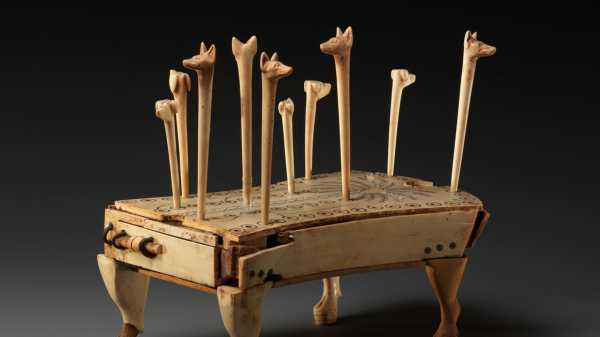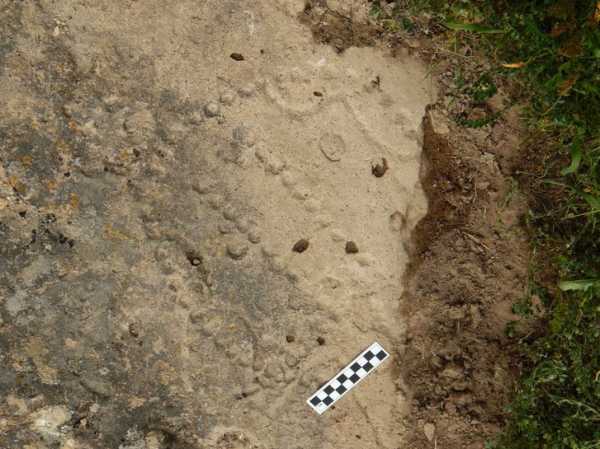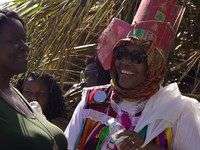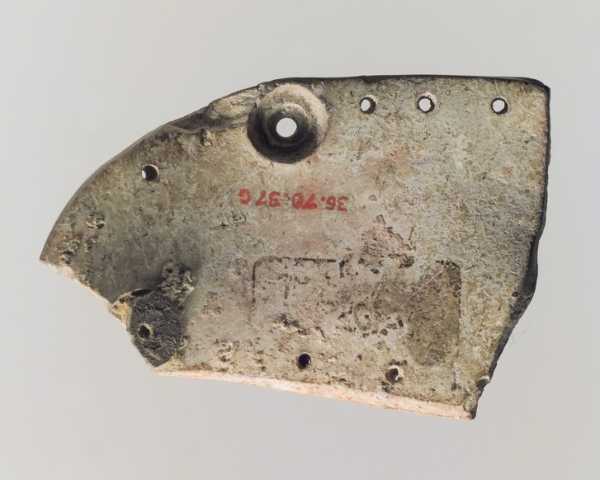
A few years ago, almost by accident, Walter Crist happened upon one of the oldest board games in the world. Crist, who was then working toward a doctorate on ancient Cypriot board games, at Arizona State University, was searching the Internet for images of a game called Fifty-eight Holes. In the second millennium B.C., Fifty-eight Holes was the most popular game of its kind across Egypt, the eastern Mediterranean, and the Middle East, and roughly eighty boards of the game, in various degrees of incompleteness, rest in museum collections around the world. Images of these boards are well known to scholars, but the photo that Crist eventually found, on the Web site of a magazine called Azerbaijan International, was unfamiliar. Taken at an archaeological site near Baku, it showed a rock carving that bore a strong resemblance to the game’s board: two parallel rows of indentations and an outer, horseshoe-shaped run of more holes. It looked like a four-year-old’s sketch of a tree.
The site, Crist learned, had been destroyed to make way for a housing development, but he eventually got in touch with an archaeologist in Azerbaijan’s Gobustan National Park, who told him that the park held a similar carving. “I think he knew that it was a game, or that people thought it was,” Crist said. “There were other people arguing that it could be an astronomical chart, or a calendar—but nobody that had studied games in any kind of depth.” So Crist decided to go to Gobustan and find out for himself.
Crist, who completed his Ph.D. in 2016, works at the New York Public Library, as a librarian. “I’m on the academic job market, which is terrible and difficult,” he said. When he went to Azerbaijan last spring, he paid for the trip himself, appending it to a visit to Athens to attend the Twenty-first Board Game Studies Colloquium. At Gobustan, near the Caspian coast, he found a vast moonscape of rocks, caves, and mud volcanoes. Archaeologists visit the park for its six thousand petroglyphs: carvings of hunting parties, bulls, boats, and dancing stick men. The glyphs date back at least four thousand years; some might be as old as forty thousand years, reaching back into the Upper Paleolithic age. Not much is known about the artists. Most likely, they were nomadic hunters who lived in rock shelters, charted the heavens, and buried their dead.
Members of the park’s staff took Crist to a horizontal slice of stone set by an upright wall of rock. Nearby, two other slabs leaned against each other at an angle, forming a shelter in which a grown man could sit. The presumptive game board, which measured thirty-seven by twenty-one centimetres, lay near one edge of the flat surface, its holes picked out of the floor. There was no method to determine when these marks were made, but the Gobustan archaeologist told Crist that the glyphs of goats and herders on the adjacent rock face were carved around four thousand years ago. At first, the board, which was exposed to the elements, appeared to contradict one of Crist’s theories: that when ancient gamers began a game outdoors, they did so in the shade. But then he peered at the rock face and saw four bigger, deeper holes punched into it. They were used, he guessed, to hold one end of a canopy that stretched, over the platform of stone, to the rock shelter on the other side. Screened in this way from the rain and the sun, the nomads of Gobustan could have sat down to play.

A series of depressions taking the form of the game of Fifty-eight Holes on a horizontal rock surface in Azerbaijan’s Gobustan National Park.
Photograph by Walter Crist / Gobustan National Preserve
When modern archaeologists first chanced on a board of Fifty-eight Holes, they mistook it for an inkwell. The board, which was discovered in Egypt early in the nineteenth century, occupies the back of a carved hippopotamus, its hollows set amid inlaid glass on blue faience. The hippo lives at the Louvre, where Anne Dunn-Vaturi, who is something of a Fifty-eight Holes obsessive, previously worked. “Because there were big holes, they thought they were for the ink,” Dunn-Vaturi, now a researcher at the Metropolitan Museum of Art, in New York, said. She told me about Flinders Petrie, the British Egyptologist who found another board later in the nineteenth century, and who proposed that it was a game. More boards emerged from excavations in Anatolia, Israel, and Iran, the oldest of them dating back to the dawn of the second millennium B.C.
The game’s rules became clearer after 1910, when Howard Carter dug an ivory board out of a pit tomb in Thebes. Carter’s set is held by the Met, and Dunn-Vaturi took me to see it one morning, before the museum opened. The board, perched on legs sculpted like a bull’s, is the size of a paperback and shaped in the manner of a violin. (Another board that is held at the Met is even tinier, brother to a matchbox.) In the tomb, Carter also found ten slim, toothpick-like playing pieces, which can be stored in a small drawer built into the board. The heads of five of the pieces have been whittled to resemble jackals; the other five bear the heads of hounds. At the apex of the board is the goal: a hole marked by the Egyptian Shen symbol, a circle nuzzled by its tangent. Tossing dice or knucklebones, a player moved her five hounds (or jackals) in increments toward the Shen, trying to hustle them through her path of twenty-nine holes faster than her opponent. Some holes were linked by lines, as if a token could lose its place and slide backward, as in Snakes and Ladders. Some other holes were tagged with the Nefer hieroglyph, the symbol for “good”; perhaps some benefit accrued to pieces that landed there, Carter speculated. “We have before us,” he wrote, “a simple, but exciting, game of chance.”
MORE FROM
Culture Desk

The Roots of Jacinda Ardern’s Extraordinary Leadership After Christchurch

Ten Years of Swag Surfin’

St. Patrick’s Day on Montserrat

What to Do in N.Y.C. This Weekend: Isabelle Huppert, Jeffrey Gibson, and Marlow & Sons

Stepping Into the Uncanny, Unsettling World of Shen Yun

The Rise of Coffee-Connoisseur Culture
Like every other ancient board game we know, Fifty-eight Holes is a “race game,” capturing the heat of the most basic forms of human contest. “It’s like a horse race or a running race, reduced to miniature,” Irving Finkel, an Assyriologist at the British Museum, said. Finkel, who has a blizzard of a beard and hair to match, writes children’s books with titles like “Swizzle de Brax and the Blungaphone.” He is also arguably the world’s foremost expert of bygone board games. “The race-game class is the first one we have,” he said. When boards of Fifty-eight Holes were first retrieved from tombs, they were imbued with the symbolism of their funerary surroundings, their circular nature compared to that of life. The truth, Finkel said, is simpler. ”It was often too hot or too difficult, or there were long periods of time when there was bugger all to do,” he said. “Board games were played to fill time—for fun, for pleasure.”
The oldest objects that might be game boards are fragmented stone tablets with parallel rows of holes; they date from the Neolithic age, between six and twelve thousand years ago, but their purpose is unclear. (According to Dunn-Vaturi, some people believe that they’re “fire-starters,” whereby a twig spun quickly in a hollow might ignite.) Apart from Fifty-eight Holes, scholars speak with assurance of four other ancient games. One of them, the possible ancestor of backgammon, is believed to have started in Persia in the vicinity of 2000 B.C. Two others, Senet and Mehen, are depicted in the well-provisioned tomb of an Egyptian official who lived and died around 2600 B.C. Their systems of play are open to conjecture. Some historians have advanced viable ways to run Senet, although Finkel calls these rules, as reconstructed, “jolly boring,” and he expresses no surprise that the game travelled poorly outside Egypt. The fifth of the ancient quintet, Twenty Squares, is the only one for which any written rules exist. Finkel derived them from a cuneiform tablet produced by a Babylonian scribe, and he presented his account of the rules in 1990, describing how players rolled pyramidal dice and walked their seven tokens through a twenty-square board.
Finkel believes that Fifty-eight Holes may be more complex than Carter and others thought: that a player, instead of merely speeding through his or her own track, might occasionally have been able to leap into a rival’s path to attack. With its assorted pieces and knucklebones, the game is “jolly fiddly, jolly fancy,” Finkel said. “The pieces we’ve found are small and rather delicate, so it isn’t the kind of game you could play when you’re drunk, or aggressively. Everything will get broken.” For this reason, he’d once felt that Fifty-eight Holes was an indoor game. (Archaeologists have only rarely found outdoor boards for Senet, Mehen, and Twenty Squares.) But Crist’s discovery showed that people could have played Fifty-eight Holes in the open, Finkel said. “If you lived in the cave, you’d have any number of pebbles or chicken vertebrae to use for pieces. It’s marvellous that this has turned up. Most of the boards we’ve seen are rather small, made of clay or wood. This is a different kind of thing.”

A fragment believed to be part of a Fifty-eight Holes game board, from the eighteenth century B.C.
Photograph Courtesy The Metropolitan Museum of Art
The Gobustan board, if the nearby rock art can be relied upon, might push the age of Fifty-eight Holes back into the end of the third millennium B.C., closer to the first clear appearances of Senet and Twenty Squares. No one knows, as yet, where the game began; we can only pick it out along the branches of trade networks of the second millennium B.C., suggesting that merchants, soldiers, and diplomats helped Fifty-eight Holes spread wider than any other game of its time. The timing was propitious, Crist said. The Indus Valley Civilization in modern south Asia, where Twenty Squares probably originated, and the Egyptian Old Kingdom, in which Senet was played, were both heading into slow decline. “There was a reorganization of economics from Mesopotamia, going not to the east but to the north—Assyrian trading colonies going into Anatolia,” Crist said. He thinks Fifty-eight Holes acquired its wide currency as a result of these fundamental renovations of the ancient world.
There is something touchingly human in the dispersal of these games—in the vision it evokes of travellers packing for long, hard journeys and remembering to take with them something to kill time, something to satisfy their impulse to play. Anthropologists often regard these old games as novelties, Crist told me, but they can narrate plenty about their era. “Games function socially as a way for people to interact with one another,” he said. “People will play games when they vaguely know each other, to get to know one another.” The anthropologist Thomas M. Malaby, in a 2007 paper, recounted how, while studying gambling in Greece, he improved at backgammon. To the Cretans he played against, he wrote, “the potential meaning of the outcomes broadened, reflecting any of a number of new possibilities (e.g., ‘You’ve become Greek, now!’ or ‘The clever American must have found a new way to cheat’).” The ability to judge another person was valuable, Crist said. It helped find answers to important questions: Are you good enough to be part of my family? Should I trust you enough to trade with you? “This is how games passed between cultures,” Crist said. Where language cannot reveal everything, something may still be gleaned from the silent, ludic routines of a game.
Sourse: newyorker.com






